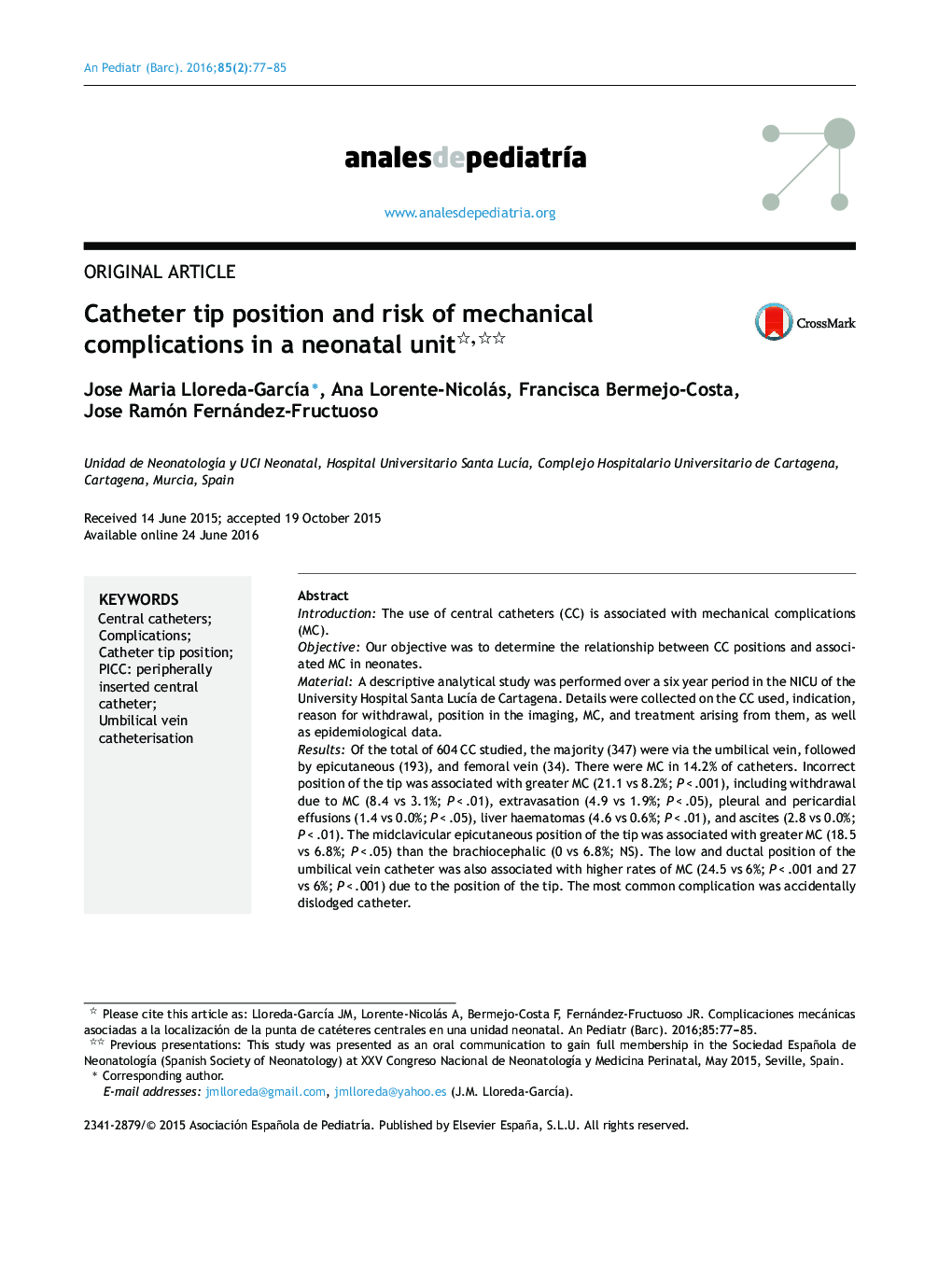| کد مقاله | کد نشریه | سال انتشار | مقاله انگلیسی | نسخه تمام متن |
|---|---|---|---|---|
| 4144933 | 1272575 | 2016 | 9 صفحه PDF | دانلود رایگان |
IntroductionThe use of central catheters (CC) is associated with mechanical complications (MC).ObjectiveOur objective was to determine the relationship between CC positions and associated MC in neonates.MaterialA descriptive analytical study was performed over a six year period in the NICU of the University Hospital Santa Lucía de Cartagena. Details were collected on the CC used, indication, reason for withdrawal, position in the imaging, MC, and treatment arising from them, as well as epidemiological data.ResultsOf the total of 604 CC studied, the majority (347) were via the umbilical vein, followed by epicutaneous (193), and femoral vein (34). There were MC in 14.2% of catheters. Incorrect position of the tip was associated with greater MC (21.1 vs 8.2%; P < .001), including withdrawal due to MC (8.4 vs 3.1%; P < .01), extravasation (4.9 vs 1.9%; P < .05), pleural and pericardial effusions (1.4 vs 0.0%; P < .05), liver haematomas (4.6 vs 0.6%; P < .01), and ascites (2.8 vs 0.0%; P < .01). The midclavicular epicutaneous position of the tip was associated with greater MC (18.5 vs 6.8%; P < .05) than the brachiocephalic (0 vs 6.8%; NS). The low and ductal position of the umbilical vein catheter was also associated with higher rates of MC (24.5 vs 6%; P < .001 and 27 vs 6%; P < .001) due to the position of the tip. The most common complication was accidentally dislodged catheter.ConclusionsThe incorrect location of the tip was associated with more MC. The midclavicular epicutaneous had more risk than centrally or brachiocephalic locations. The low and ductal positions of the umbilical vein catheter were associated with higher rates of MC.
ResumenIntroducciónEl uso de catéteres centrales (CC) está asociado a complicaciones mecánicas (CM). Nuestro objetivo fue conocer si la posición incorrecta de la punta se asociaba con mayor incidencia de CM.MaterialEstudio descriptivo de 6 años en la UCIN del Hospital Universitario Santa Lucía de Cartagena. Se recogieron los CC, la indicación, el motivo de retirada, la posición en las pruebas de imagen, las CM y el tratamiento derivado.ResultadosSe estudiaron 604 CC, la mayoría (347) de vena umbilical, epicutáneos (193) y de vena femoral (34). El 14,2% tuvo CM. La posición incorrecta de la punta se asoció a mayores CM (21,1 vs. 8,2%; p < 0,001), retirada por problemas mecánicos (8,4 vs. 3,1%; p < 0,01), extravasación (4,9 vs. 1,9%; p < 0,05), derrames pleurales y pericárdicos (1,4 vs. 0,0%; p < 0,05), hematomas hepáticos (4,6 vs. 0,6%; p < 0,01) y ascitis (2,8 vs. 0,0%; p < 0,01). Los epicutáneos medioclaviculares se asociaron a mayores CM (18,5 vs. 6,8%; p < 0,05) que los localizados en posición braquiocefálica (0 vs. 6,8%; NS) respecto a las localizaciones correctas. La posición baja o en ductus del catéter venoso umbilical se asoció a mayores CM respecto a la posición correcta (24,5 vs. 6%; p < 0,001. y 27 vs. 6%; p < 0,001). La complicación más frecuente fue la salida accidental.ConclusionesLas localizaciones incorrectas de la punta de los CC se asociaron a más CM. Los epicutáneos medioclaviculares tuvieron más riesgo que los localizados en cavas o braquiocefálicos. La posición baja o en ductus del catéter venoso umbilical se asoció a mayores CM.
Journal: Anales de Pediatría (English Edition) - Volume 85, Issue 2, August 2016, Pages 77–85
